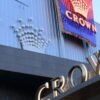Posted on: May 22, 2024, 07:19h.
Last updated on: May 22, 2024, 07:29h.
The Neon Museum in Las Vegas on Tuesday unveiled its first signage from the Flamingo, the oldest resort on the Strip.

“This gives us a chance to really talk about everything from the mob to the influence of entertainment,” Aaron Berger, the Neon Museum’s executive director, told KVVU-TV/Las Vegas. “Entertainment really gets its hooks into the Flamingo.”

Not That Original
Unfortunately, these signs are not from what anyone would consider the casino resort’s classic period. They date back only to 1976, five years after the hotel had already become the Flamingo Hilton. (It reverted to its original name in 2001.)
The pylon sign is only a recreation of a 1967 pylon sign designed by Ad-Art’s Bill Clarke, which was not saved.
Though people criticize today’s Las Vegas for having no regard for its architectural history, the problem was much worse from the 1940s through the 1970s.
Almost nothing from the original Las Vegas was salvaged for prosperity.
The resort called the Flamingo today features none of the structures it opened with in December 1946. The last original building — which featured former owner Bugsy Siegel’s office — was demolished during a 1995 renovation.
This makes these newly restored signs the Flamingo’s oldest surviving architectural relic.
The cost of their restoration, believed to be in the six figures, was footed by three main donors: Andrew Pascal, CEO of online gambling company Play Studios and nephew of Steve Wynn; Felicia French, CEO of textile company Opuzen; and Emily Conner Cooper, the widow of Las Vegas comedian Pat Cooper, who died in 2023 at age 93. (Cooper’s first Las Vegas gig was at the Flamingo in 1963.)

Hiding in Plain Sight
The Neon Museum has secretly had the newly restored signs on display in its “neon boneyard” — the backlot where museumgoers wander through its sign collection — since they were donated by the Flamingo in 2003, though this is the first time they were restored and publicly identified. (The “Flamingo” lettering was not saved.)
Much like a real flamingo sticking its head in the sand, the top of the pylon sign had been hiding in plain sight — in pieces behind the “Wedding Information” sign used in the 1940s at the Ali Baba Wedding Center by the airport.
Thousands of couples springing for the museum’s $950 an hour wedding rental fee have it in the background of their wedding photos and don’t even know it.
A third Flamingo feather plume, also believed to be from the 1970s, is still on display in the boneyard, unrestored.
Signing Off

The pylon sign was removed in 1987 to make room for O’Shea’s Casino, which would open on the site two years later. (O’Shea’s was demolished in 2012 and a smaller version opened in the Linq Promenade the following year.)
Fortunately, the Hilton Corporation placed the top of the pylon sign in storage on the Flamingo property after its removal.
No replacement Flamingo sign was ever constructed, since the current Flamingo sign, nicknamed the “bull nose,” has advertised the resort’s famous name in a sufficiently large manner to the Las Vegas Strip since it was added during a 1977 renovation.
What’s the Big Deal?
The Flamingo is the oldest surviving resort name on the Strip, having opened in December 1946. Its name is imprinted forever on pop culture because of Hollywood’s fascination with the mobster who opened it. However, Bugsy Siegel is given too much credit by pop culture for building the Flamingo.
The casino resort’s original concept and name came from Billy Wilkerson, publisher of the Hollywood Reporter, who faced financial problems during construction which led him to take on Siegel as a business partner — a decision he regretted when Siegel forced him out of the project under threat of force.









